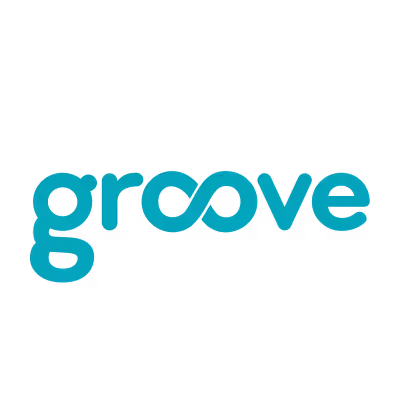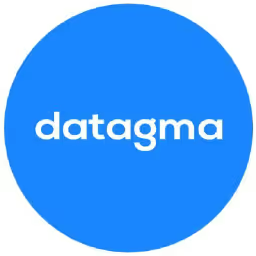Slintel Alternatives
Explore 10 Slintel alternatives. A direct comparison of features, pricing, and data accuracy to help you find the right sales intelligence tool.

You might be using Slintel for its accurate data or helpful Chrome extension. Many users find its buyer intent and technographic information useful for identifying prospects. It's a solid tool for specific sales intelligence tasks and performs well in these areas.
However, some users report that the data can sometimes be out-of-date or that the pricing is a bit high. We've analyzed the top alternatives to help you choose. We compared their advantages and drawbacks to Slintel based on G2 reviews. Let's get started.
Consider 11x for Your Sales Team
If your sales process could benefit from digital workers, consider 11x. These workers handle tasks like lead research and data entry. This frees up your sales team to focus on deals rather than manual work.
11x is a go-to-market platform that uses AI agents to handle parts of the sales process. These agents are designed to manage specific sales functions automatically.
For example, an agent named Alice finds prospects, conducts outreach on email and LinkedIn, and updates your CRM. Another agent, Julian, qualifies inbound leads and schedules meetings.
The platform combines functions that often require separate tools. This includes data enrichment, sales outreach, and email warmup, all within a single system.
Slintel Alternatives
Below is a detailed breakdown of the top alternatives to Slintel. We will examine each tool's pricing, features, and its specific pros and cons when measured against Slintel.
1) ZoomInfo SalesOS
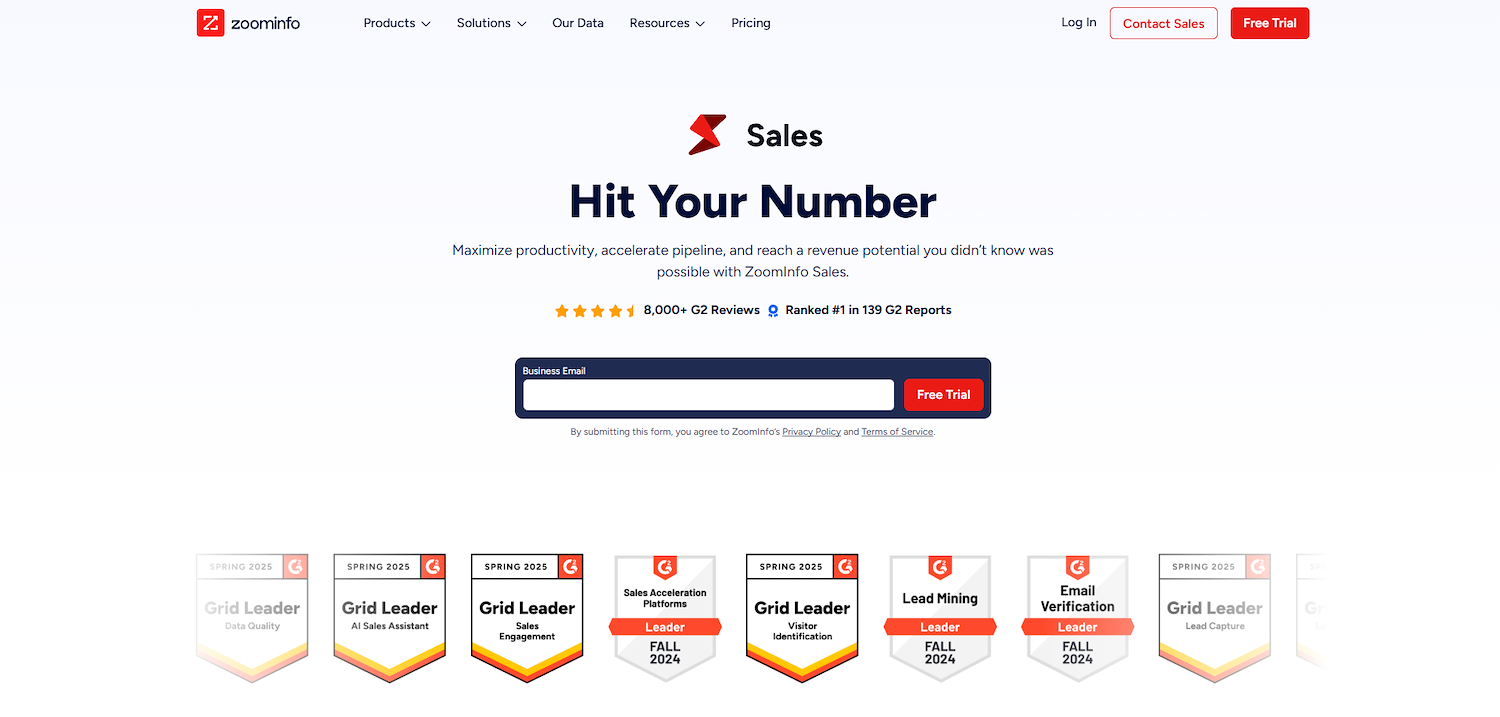
ZoomInfo SalesOS is a platform to accelerate revenue for B2B organizations. It combines a B2B contact database with intent signals and AI insights to help sales, marketing, and RevOps teams maximize productivity.
The system supports intelligent prospect discovery through buyer-intent signals and web activity. It also helps to engage the right buyers with automated workflows and enriched lead data for better database hygiene.
ZoomInfo SalesOS's Main Features
- The platform provides access to a database with over 70 million direct-dial phone numbers and 174 million verified email addresses.
- Its conversation intelligence feature, Chorus, analyzes calls, meetings, and emails to help refine sales processes.
- An AI assistant, ZoomInfo Copilot, automatically generates emails, chat summaries, and talk tracks to support sales activities.
- Workflows trigger automated outreach based on intent signals, technographics, or other market indicators.
How ZoomInfo SalesOS Compares to Slintel
Average Review score: 4.5/5 stars based on 8,738 G2 reviews.
- ZoomInfo SalesOS provides a larger contact database compared to Slintel, with over 70 million direct-dial numbers and 174 million verified emails.
- It includes a conversation intelligence tool, Chorus, which analyzes sales calls and emails. This feature offers deeper insights into sales interactions than Slintel's standard data points.
- The platform offers an AI assistant called Copilot. This tool automates content creation like emails and talk tracks, a function not available in Slintel.
- Unlike Slintel, ZoomInfo SalesOS has advanced data cleaning and enrichment features. This helps maintain better database hygiene by automatically updating and correcting contact information.
Drawbacks of ZoomInfo SalesOS vs. Slintel
- The platform's cost is perceived as high, and it may take over a year to see a return on investment. This can be a significant factor for smaller teams when compared to Slintel.
- Some users report that contact or company data is occasionally inaccurate or outdated. This is a point of feedback for ZoomInfo SalesOS, especially given the size of its database.
- Its implementation can take up to a month, which is a longer setup period. In contrast, some teams find Slintel's platform quicker to integrate into their existing workflows.
Pricing and Cost-Effectiveness
ZoomInfo SalesOS follows a custom pricing model and is generally perceived as a more significant investment compared to Slintel. For the most accurate pricing, we recommend visiting ZoomInfo's official website to request a quote.
2) Apollo.io
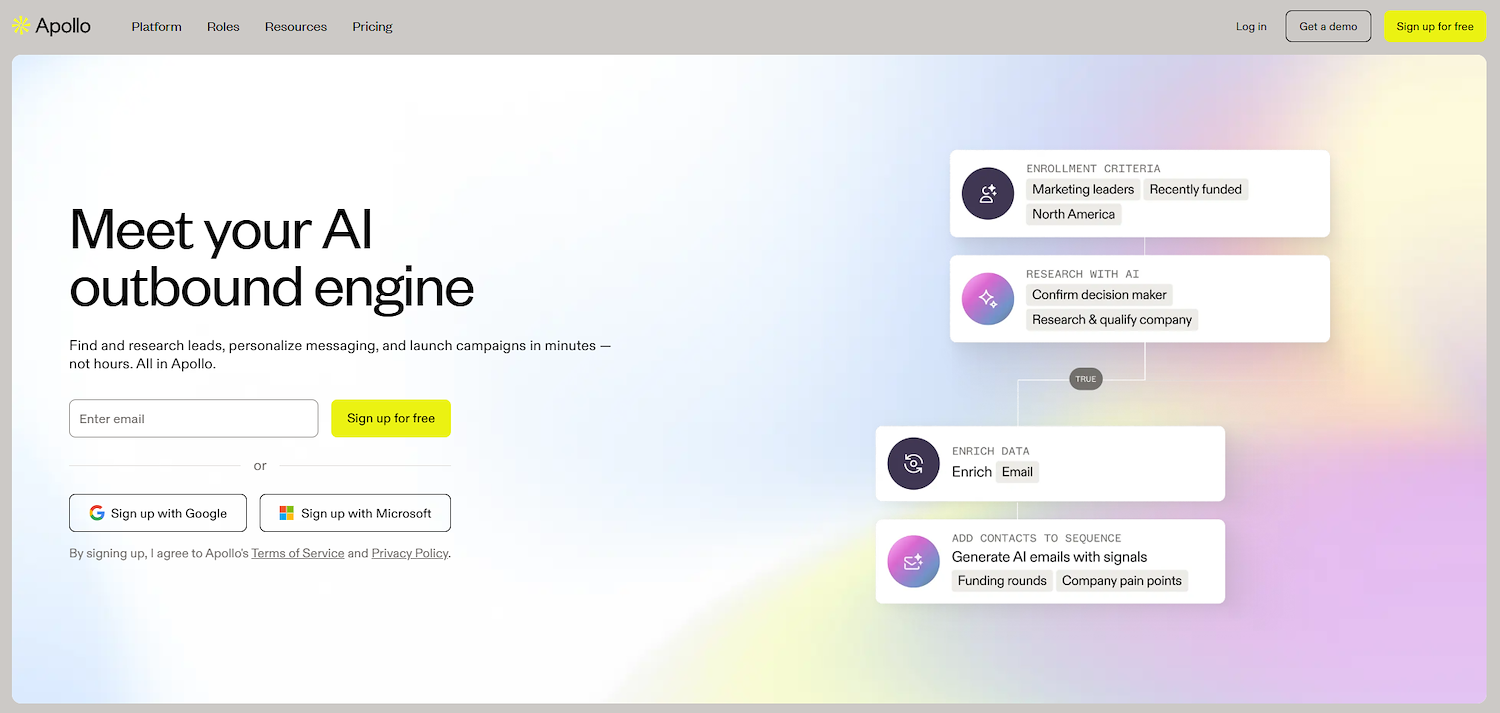
Apollo.io is a sales intelligence and engagement platform. It provides access to a B2B database for sales and marketing teams and includes tools for outreach and analytics.
The system allows users to find contacts, automate email sequences, and manage sales workflows. It combines data, engagement, and automation features into a single platform to cover the sales cycle.
Apollo.io's Main Features
- Provides access to a B2B database to find contacts and build lists.
- Includes tools to automate email sequences and manage sales outreach.
- Combines data, engagement, and automation features into a single platform.
- Offers analytics tools to track the results of sales campaigns.
How Apollo.io Compares to Slintel
Average Review score: 4.7/5 stars based on 8,904 G2 reviews.
- Apollo.io combines sales intelligence with engagement tools in one platform, while Slintel focuses primarily on providing data and intent signals.
- The platform offers a free pricing tier, which makes it accessible for smaller teams. This is different from Slintel, which users sometimes report as having a higher cost.
- It provides access to a database with over 210 million contacts. This gives users a larger contact pool for prospect searches compared to Slintel.
- The tool includes features to automate outreach, such as email sequences. This function is not a native part of the Slintel platform.
Drawbacks of Apollo.io vs. Slintel
- Some users report that contact information in Apollo.io can be inaccurate. In contrast, Slintel is often noted for the reliability of its technographic and buyer intent data.
- The platform's buyer intent signals might be less detailed compared to Slintel. Slintel's primary focus on intent data can provide more granular insights for specific use cases.
- Its all-in-one nature can introduce a learning curve for new users. Teams that need a dedicated intent data tool might find Slintel's focused platform easier to navigate.
Pricing and Cost-Effectiveness
Apollo.io offers a transparent pricing model with a free tier and paid plans starting at $49 per user monthly. This makes it more accessible for smaller teams compared to Slintel, which is often reported to have a higher cost and lacks a free plan. For the most accurate pricing, we recommend visiting Apollo.io's official website.
3) 6sense Revenue AI
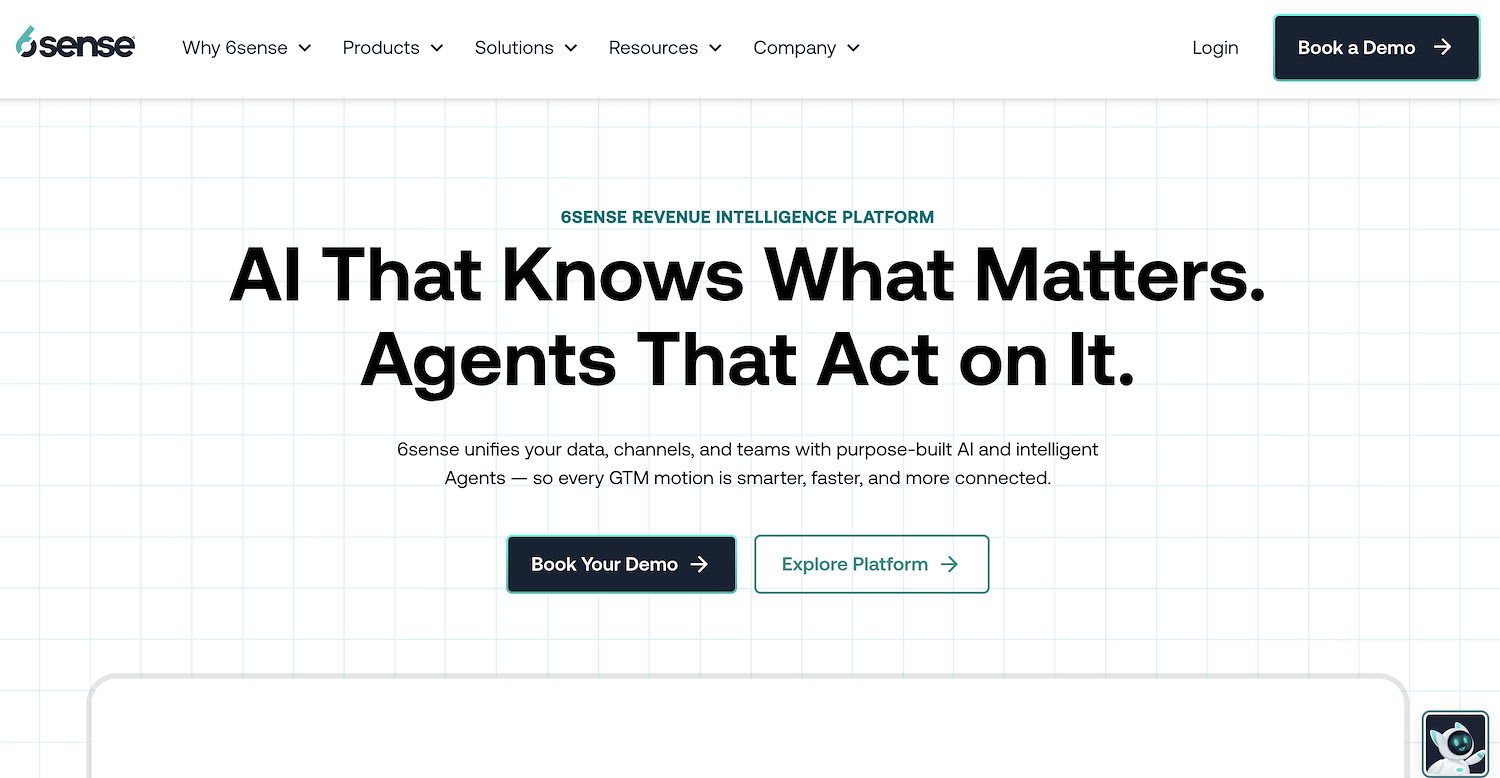
6sense Revenue AI is a B2B revenue-intelligence platform that unifies data, channels, and go-to-market teams. Its AI processes buying signals to predict pipeline, prioritize accounts, and automate outreach across ads, email, and web.
The platform supports account-based marketing, sales automation, and deal acceleration. It connects marketing, sales, and revenue operations for a unified GTM motion.
6sense Revenue AI's Main Features
- The platform's Signalverse data fabric collects intent, company, and contact data and performs web deanonymization.
- Its Intelligent Workflows Engine uses a drag-and-drop canvas to turn AI signals into omni-channel plays across ads, email, and web.
- AI Agents autonomously personalize emails, respond to prospects, and book meetings for sales teams.
- A Competitive Takeout feature detects when accounts research competitors and launches targeted ads and agent outreach.
How 6sense Revenue AI Compares to Slintel
Average Review score: 4.3/5 stars based on 1,086 G2 reviews.
- 6sense Revenue AI uses AI to predict which accounts are most likely to buy, offering a more targeted approach than Slintel's broader intent data signals.
- Its AI Agents autonomously handle outreach tasks like personalizing emails and booking meetings, automating a step that users perform manually with data from Slintel.
- The platform identifies anonymous website visitors and personalizes their experience on the site, a feature not central to Slintel's data-focused offering.
- It orchestrates campaigns across multiple channels like ads and email, while Slintel primarily provides the intelligence without the built-in execution tools.
Drawbacks of 6sense Revenue AI vs. Slintel
- 6sense Revenue AI can be complex for new users because of its extensive features. In comparison, Slintel's focused platform for specific data tasks sometimes offers a more straightforward user experience.
- Its implementation may take up to three months, which is a longer setup period. Teams that need a faster integration might find Slintel's platform quicker to adopt into their existing workflows.
- While 6sense covers a wide range of functions, some users report occasional data inaccuracies. Slintel is often noted for the reliability of its technographic and buyer intent data, as this is its primary focus.
Pricing and Cost-Effectiveness
6sense Revenue AI operates on a custom pricing model and is considered a premium investment, similar to Slintel. For the most accurate pricing, we recommend visiting the 6sense G2 page for more details or contacting the company directly for a quote.
4) Demandbase One

Demandbase One is a go-to-market platform for B2B companies. It connects account intelligence with actions for marketing and sales teams. The system helps find and prioritize accounts, engage buyers, and support advertising and sales efforts.
Demandbase One's Main Features
- The platform combines marketing, sales intelligence, advertising, and data modules into a single interface.
- It uses autonomous agents, called Agentbase, to surface recommendations and automatically execute actions.
- The system detects and visualizes entire buying groups rather than focusing on single contacts.
- A native B2B DSP allows for intent-based, hyper-targeted advertising for account-based marketing campaigns.
How Demandbase One Compares to Slintel
Average Review score: 4.4/5 stars based on 1,843 G2 reviews.
- Demandbase One uses autonomous agents to suggest and perform actions. This differs from Slintel, which provides data for your team to act on manually.
- It maps out entire buying groups inside a target account. In comparison, Slintel's focus is more on individual contacts.
- The platform has a built-in advertising tool for account-based marketing. This lets you use intent data for ads directly, an option Slintel does not offer.
- This tool combines marketing, sales, and advertising functions into one platform. Slintel, on the other hand, focuses on providing sales intelligence data.
Drawbacks of Demandbase One vs. Slintel
- Demandbase One sometimes presents a steep learning curve due to its extensive features. In comparison, Slintel's focused platform can be easier for teams to adopt for specific data needs.
- Its implementation may take around two months to complete. This is a longer setup period compared to Slintel, which some teams find quicker to integrate into their workflows.
- Some users find that contact information for specific roles is occasionally incomplete. In contrast, Slintel is often noted for the reliability of its technographic and buyer intent data.
Pricing and Cost-Effectiveness
Demandbase One operates on a custom pricing model and is considered a premium investment, similar to Slintel. For the most accurate pricing, we recommend visiting the Demandbase One official website to request a quote.
5) Lusha
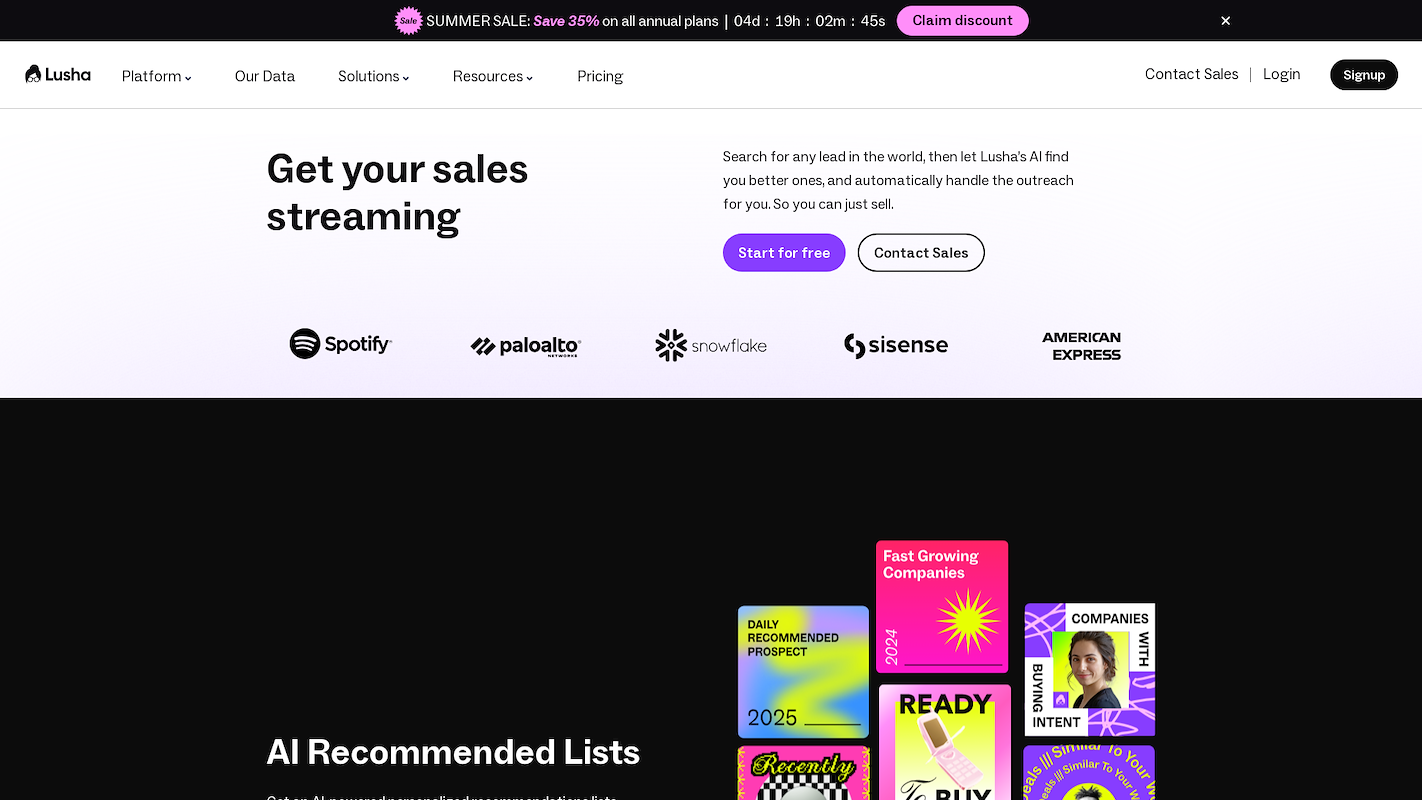
Lusha is a sales intelligence platform for B2B companies to access contact and company data. The system delivers verified email addresses and direct-dial phone numbers for prospects.
Users can find data on individual profiles or enrich their CRM systems in bulk. The platform helps sales and recruitment teams build accurate prospect lists for outreach campaigns.
Lusha's Main Features
- The platform's recommendation engine curates daily, ICP-based lists of companies and decision-makers.
- Its Engage feature uses AI copy to automate and personalize email outreach sequences.
- Lusha Conversations records and analyzes sales meetings to provide insights into sales calls.
- A browser extension allows users to capture contact data directly from LinkedIn and other websites.
How Lusha Compares to Slintel
Average Review score: 4.3/5 stars based on 1,516 G2 reviews.
- Lusha offers AI Prospect Playlists that automatically create lead lists. This is different from Slintel, where users typically build lists manually from the provided data.
- Its Engage feature uses AI to write and send personalized email sequences. Slintel provides intent data but does not include a similar built-in tool for outreach.
- The tool includes Lusha Conversations to record and analyze sales meetings for insights. This provides a layer of sales interaction analysis that is absent in Slintel's core offering.
- The platform's free plan and transparent pricing make it accessible for smaller teams, in contrast to Slintel, which is often reported to have a higher cost and no free option.
Drawbacks of Lusha vs. Slintel
- Lusha's buyer intent signals are sometimes less detailed compared to Slintel. Slintel's primary focus on this data can provide more specific insights for sales teams.
- Some users report that contact information in Lusha can be inaccurate. In contrast, Slintel is often noted for the reliability of its technographic and buyer intent data.
- The platform's all-in-one nature can introduce a learning curve. Teams that need a dedicated intent data tool might find Slintel's focused platform easier to navigate.
Pricing and Cost-Effectiveness
Lusha offers a transparent pricing model with a free plan and paid tiers starting at $36 per user monthly, making it accessible for smaller teams. This contrasts with Slintel, which uses a custom pricing model and is often considered a more significant investment. For detailed costs, we recommend visiting Lusha's official website.
Our Recommendation: Consider 11x
If you want to automate parts of your sales process, consider 11x. Its digital workers manage tasks like lead research and data entry, freeing up your team for selling. You can see how it works by booking a demo.
At 11x, we use AI to run your sales playbook. Alice identifies accounts, adds data, and handles outreach. Julian manages calls, qualifies leads, and sets meetings. Our platform includes intent signals and email warmup, which replaces other tools in your GTM stack.
Book a demo to see 11x in action.
6) Cognism
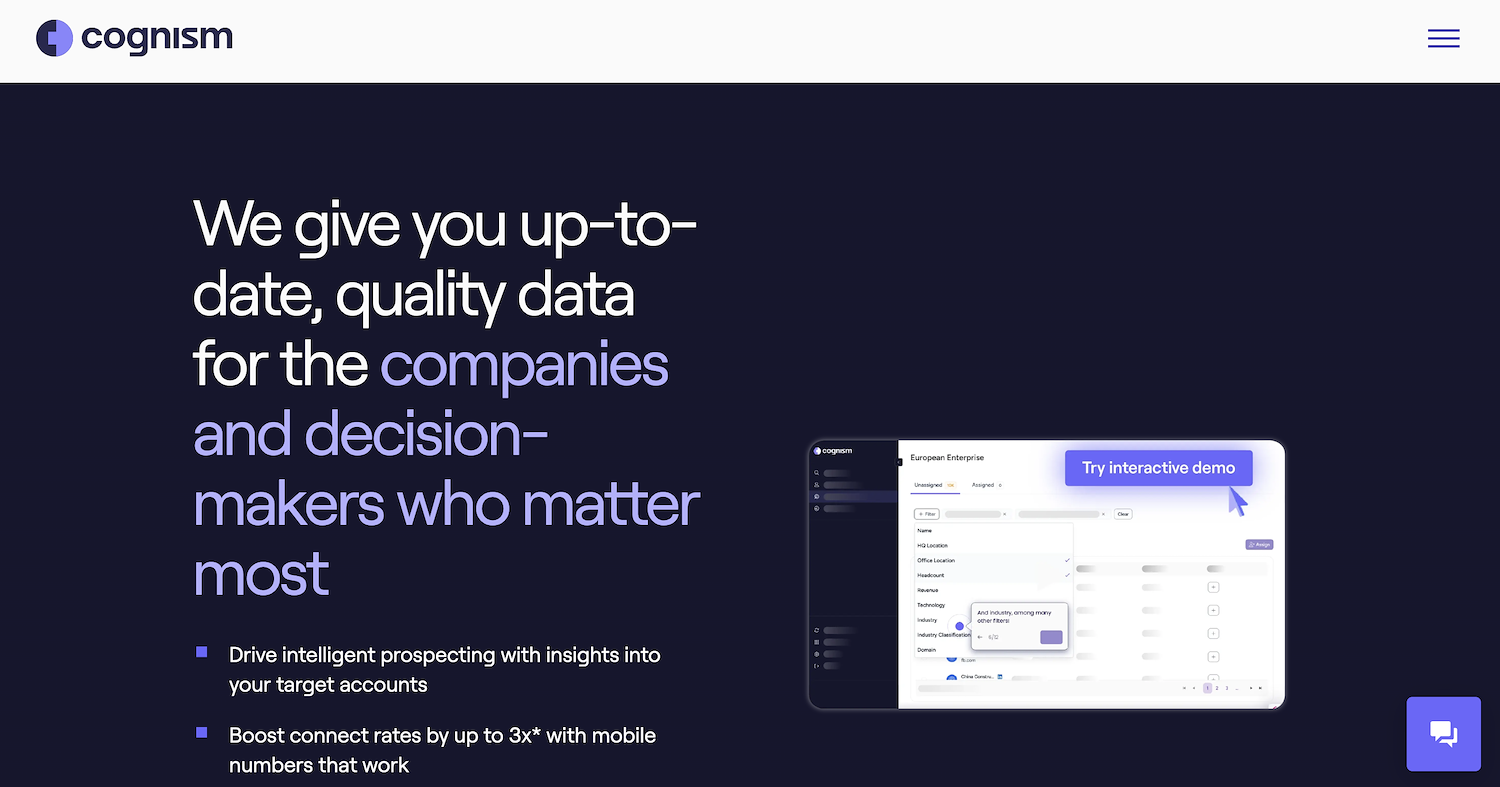
Cognism is a sales intelligence platform that provides B2B contact and company data. It offers verified contact details, including direct-dial phone numbers, to help sales teams connect with prospects. The platform focuses on data compliance, particularly for operations in Europe.
Its primary use is for lead generation and data enrichment. Sales teams can build accurate prospect lists or update their CRM with fresh information to support outreach campaigns.
Cognism's Main Features
- The platform provides phone-verified, human-checked mobile numbers, called Diamond Data®, to increase connection rates.
- It offers extensive coverage of mobile numbers and email addresses for contacts in the UK and EMEA regions.
- The system surfaces buying signals from hiring trends, funding rounds, and technographic changes for outreach.
- It enriches CRM records in bulk through CSV or API to complete and refresh contact information.
How Cognism Compares to Slintel
Average Review score: 4.6/5 stars based on 1,033 G2 reviews.
- Cognism provides extensive contact data for European markets, with a focus on GDPR compliance. This differs from Slintel's primary strength in technographic data.
- It offers phone-verified mobile numbers, known as Diamond Data®, which are checked by a research team. This adds a verification step not specified in Slintel's process.
- The platform surfaces buying signals from events like company funding and hiring trends. Slintel, in comparison, centers its intelligence on buyer intent and technology usage.
- Users can enrich their CRM records in bulk to update and complete contact information. This is a direct data management feature, while Slintel provides intelligence for teams to act on.
Drawbacks of Cognism vs. Slintel
- Some users report that Cognism's intent signals, based on company events, are less direct than Slintel's. Slintel provides data on what topics a company actively researches, which can offer more specific buying signals.
- Its technographic data might not be as detailed as Slintel's. Slintel specializes in this area, often giving a more complete view of a company's tech stack for highly specific sales plays.
- The platform's broad feature set can sometimes create a learning curve for new users. In comparison, teams may find Slintel's focused approach on intent and technographics simpler to adopt for specific data tasks.
Pricing and Cost-Effectiveness
Cognism operates on a custom pricing model and is considered a premium investment, similar to Slintel. For the most accurate pricing, we recommend visiting Cognism's official website to request a quote.
7) Clearbit
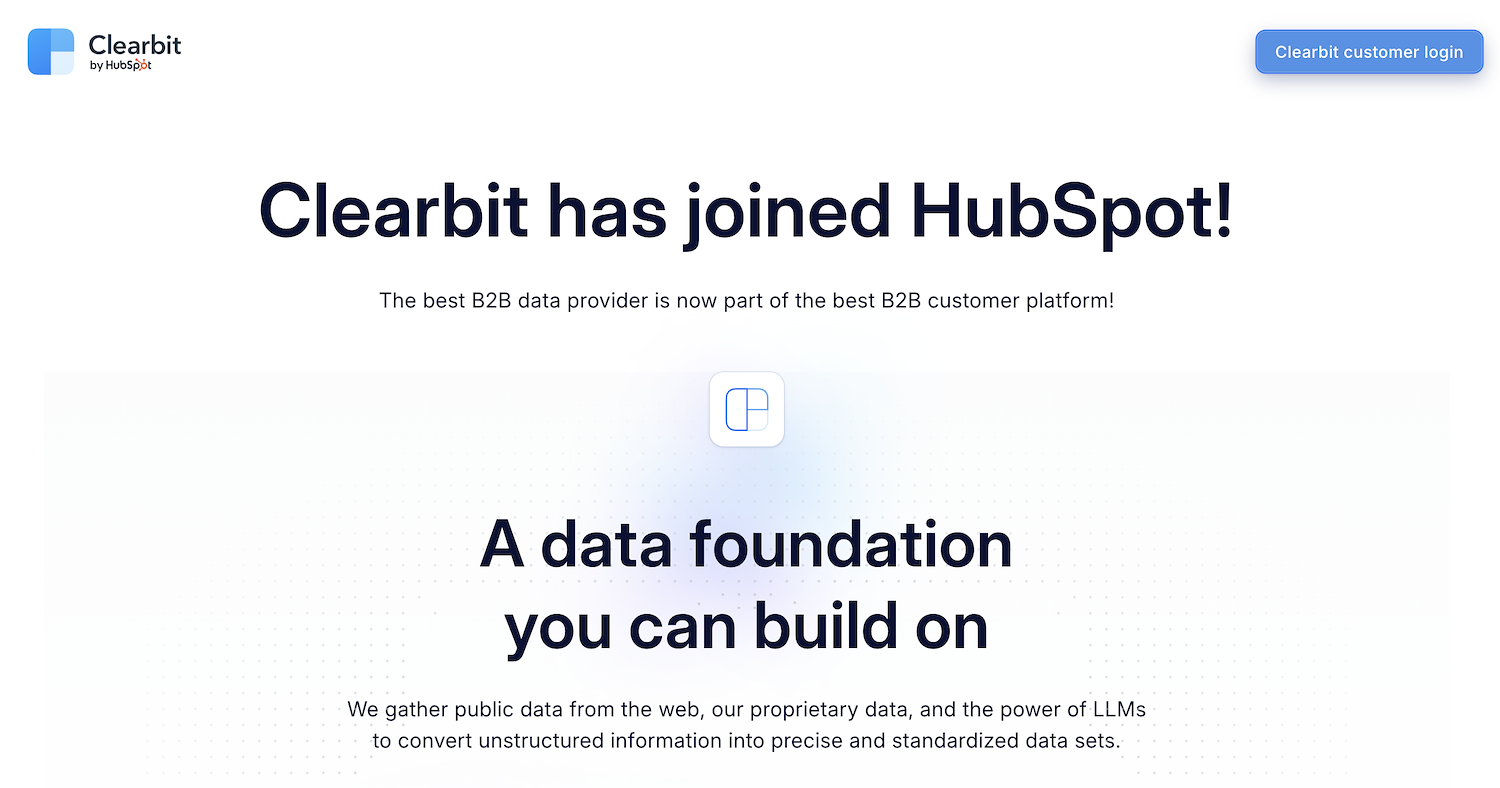
Clearbit is a data platform for B2B companies. It provides company and contact information for marketing and sales teams. This data helps them enrich customer profiles, identify ideal prospects, and personalize outreach based on real-time signals.
Clearbit's Main Features
- The platform enriches lead, contact, and account records with firmographic and demographic details by processing public and proprietary data with LLMs.
- It provides real-time lead scoring and routing using data points like 6-digit NAICS codes and corporate hierarchy mapping.
- The system de-anonymizes website traffic to identify visiting companies that match the ideal customer profile.
- It shortens web forms by automatically enriching fields, which reduces friction and can increase conversion rates.
How Clearbit Compares to Slintel
Average Review score: 4.4/5 stars based on 626 G2 reviews.
- Clearbit enriches lead records in real-time and shortens web forms, which can increase conversions. Slintel provides data but does not have a comparable feature for web forms.
- It identifies anonymous companies that visit your website and creates a direct source of new leads. This differs from Slintel, which focuses on intent signals from across the web rather than your own site traffic.
- The platform scores and routes leads in real-time based on over 100 data points. This process is more automated compared to the manual evaluation of leads with data from Slintel.
- This tool integrates deeply with marketing automation platforms like HubSpot and triggers automated workflows. While Slintel also integrates with CRMs, Clearbit uses its data to directly initiate actions within another system.
Drawbacks of Clearbit vs. Slintel
- Clearbit's buyer intent signals are sometimes less detailed compared to Slintel's. The platform focuses on intent from your website visitors, while Slintel provides a broader view from research topics across the web, which can offer more specific buying signals.
- The platform's technographic data might not be as detailed as what Slintel provides. Slintel specializes in this area and often gives a more complete view of a company's tech stack, which is useful for highly targeted sales campaigns.
- Its deep integration with marketing automation can be complex for teams that only need a data provider. In comparison, some users find Slintel's focused platform simpler to adopt for specific intelligence tasks without the added workflow features.
Pricing and Cost-Effectiveness
Clearbit operates on a custom pricing model and is considered a premium investment, similar to Slintel. For the most accurate pricing, we recommend visiting Clearbit's official website to request a quote.
8) Seamless.AI
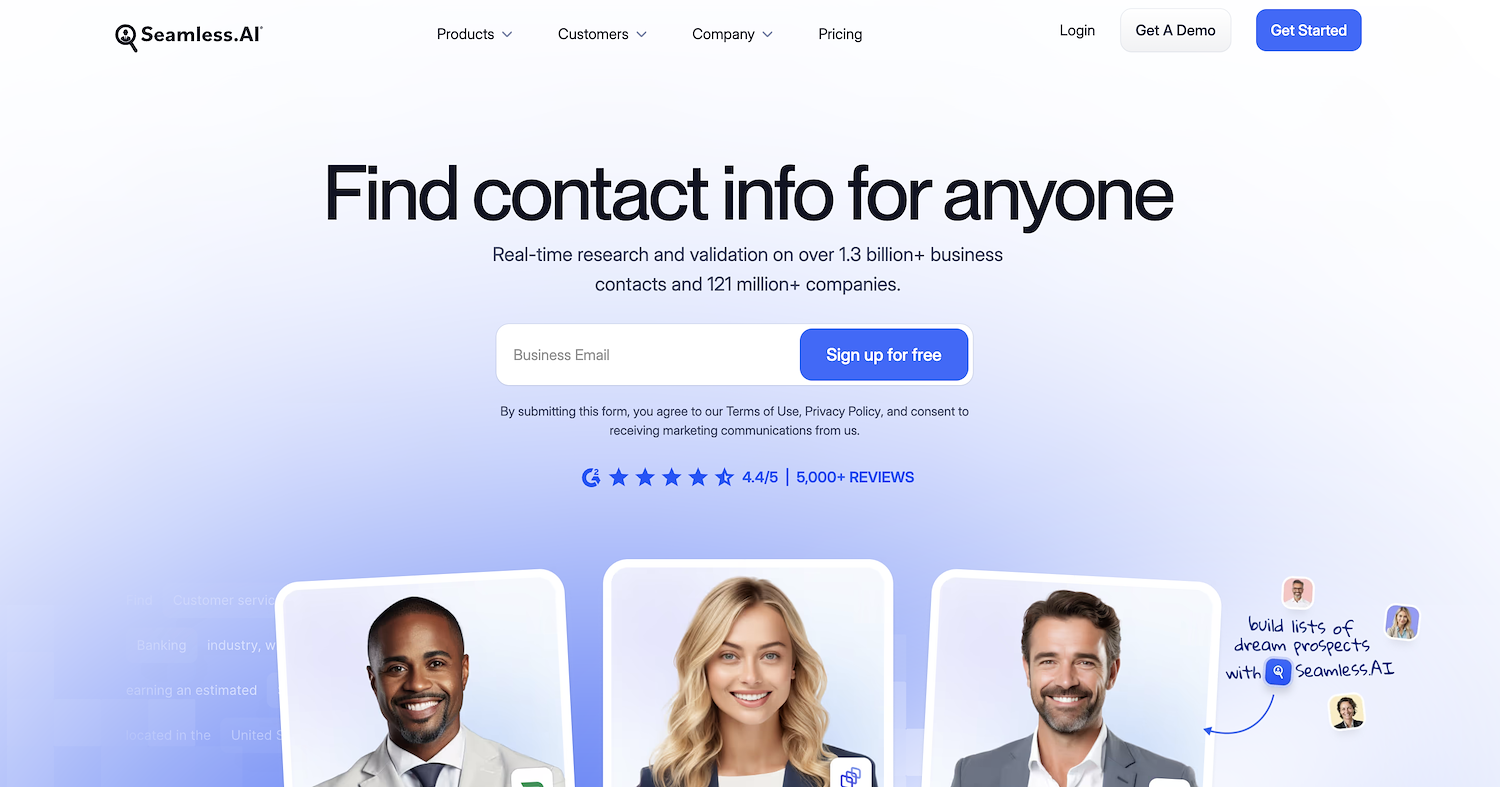
Seamless.AI is a real-time search engine for B2B data. It provides verified emails, direct dials, and cell numbers for professionals. Sales and marketing teams use the platform to build prospect lists or enrich CRM data. An AI system validates the contact information in real-time.
Seamless.AI's Main Features
- The platform includes a lead builder to access its database of contacts and company profiles.
- It integrates with CRM and marketing automation systems, including Salesforce and HubSpot.
- The system provides data cleaning, enrichment, and validation to maintain lead quality.
- It offers lead intelligence features that include buyer intent data and job change tracking.
How Seamless.AI Compares to Slintel
Average Review score: 4.4/5 stars based on 5,067 G2 reviews.
- Seamless.AI operates as a real-time search engine for contact data, offering immediate access to information. This differs from Slintel's focus on curated intent and technographic signals.
- The tool tracks job changes as a buying signal. This provides a different type of lead intelligence than Slintel, which centers on a company's technology stack and online research topics.
- It uses an AI system to validate contact information in real-time during a search. This is a different approach to data accuracy compared to Slintel's method of providing pre-verified data sets.
- With access to over 1.7 billion contacts, the platform offers a larger pool for prospecting. Slintel, in comparison, provides a more specialized dataset focused on technographics.
Drawbacks of Seamless.AI vs. Slintel
- Some users report that the technographic data in Seamless.AI is less detailed. In comparison, Slintel specializes in this area, often providing a more complete view of a company's tech stack for specific sales plays.
- The platform's buyer intent signals can be less specific than Slintel's. Slintel focuses on what topics a company actively researches across the web, which may offer more direct buying signals for sales teams.
- Its data accuracy can sometimes be a concern for users, with reports of outdated contact information. In contrast, Slintel is often noted for the reliability of its data, especially for technographics and buyer intent.
Pricing and Cost-Effectiveness
Seamless.AI is perceived as a premium investment, similar to Slintel, but it provides free credits that some users find valuable. For the most accurate pricing, we recommend visiting the Seamless.AI official website.
9) Lead411
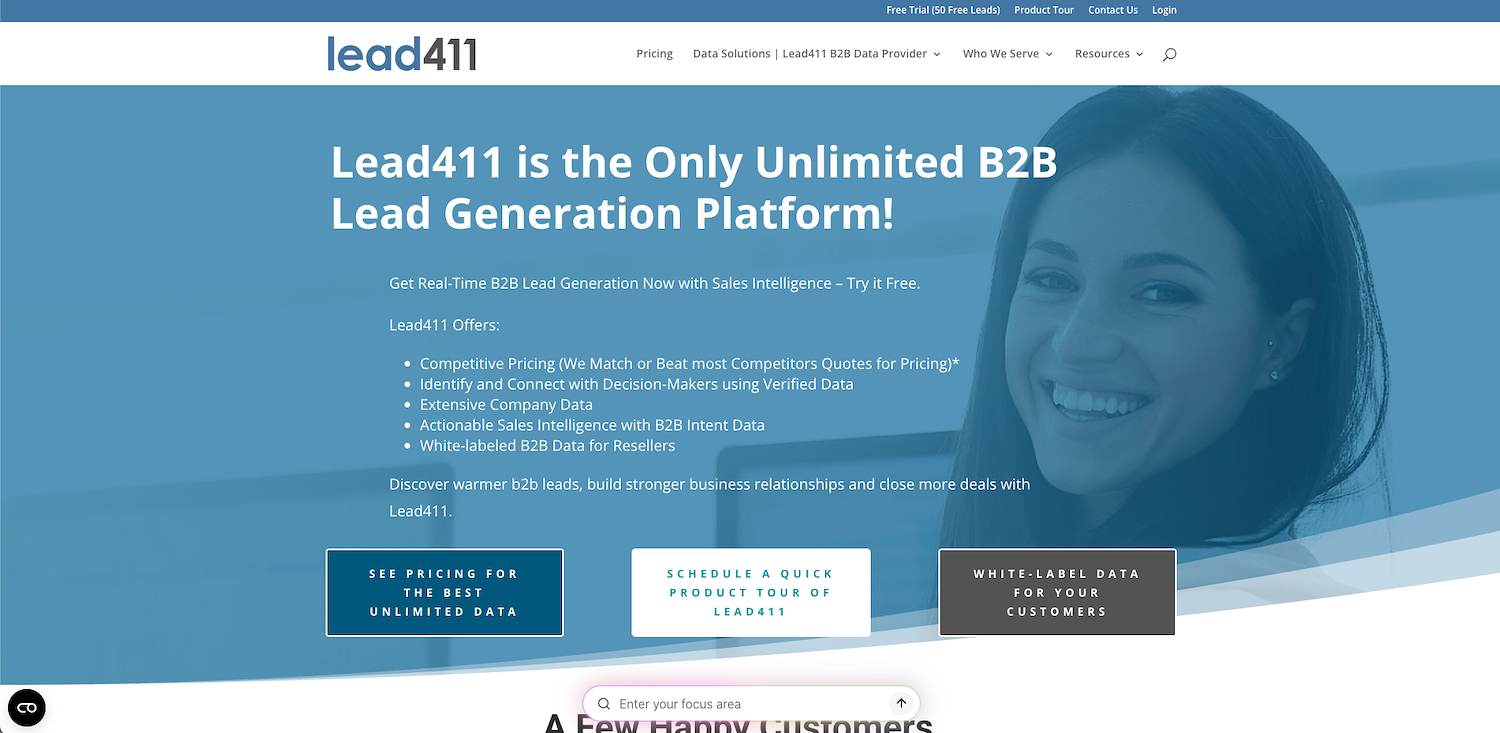
Lead411 is a B2B data platform that provides company and contact information for sales and marketing teams. Professionals use the service to build prospect lists and find new leads. The platform's data helps identify potential customers for outreach campaigns and adds verified contact details to sales pipelines.
Lead411's Main Features
- The platform provides growth intent data, including signals like recent funding, hiring plans, and IPO announcements.
- It offers buyer intent data powered by Bombora to identify companies researching specific topics.
- The system includes a Reach feature for creating and managing automated email outreach campaigns directly within the platform.
- An A.I. dashboard automatically tracks key indicators to surface high-priority leads.
How Lead411 Compares to Slintel
Average Review score: 4.5/5 stars based on 466 G2 reviews.
- Lead411 provides growth intent signals, such as company funding and hiring plans. This is different from Slintel, which focuses more on buyer intent from web research topics.
- The platform includes a built-in feature for email outreach. This allows users to act on data directly, while Slintel requires a separate tool for campaigns.
- It has an A.I. dashboard that automatically highlights priority leads. This offers more automation compared to Slintel, where users often analyze data manually.
- This tool uses Bombora for its buyer intent data, a widely recognized source. Slintel uses its own methods, which provides a different type of intent signal.
Drawbacks of Lead411 Compared to Slintel
- Some users report that Lead411's technographic data is less detailed than Slintel's. Slintel often provides a more complete view of a company's tech stack, which is useful for highly specific sales campaigns.
- Its buyer intent data comes from Bombora, which can be less granular than Slintel's proprietary signals. Slintel's focus on specific research topics may offer more direct buying signals for certain teams.
- The platform includes an email outreach feature, which might add complexity for teams that only need a data provider. In contrast, Slintel's focused platform can be simpler to adopt for specific intelligence tasks.
Pricing and Cost-Effectiveness
Lead411 offers a transparent pricing model with its Basic plan starting at $75 per user monthly. This contrasts with Slintel's custom pricing model, which is often considered a more significant investment. For the most accurate pricing, we recommend visiting the Lead411 official website.
10) Bombora
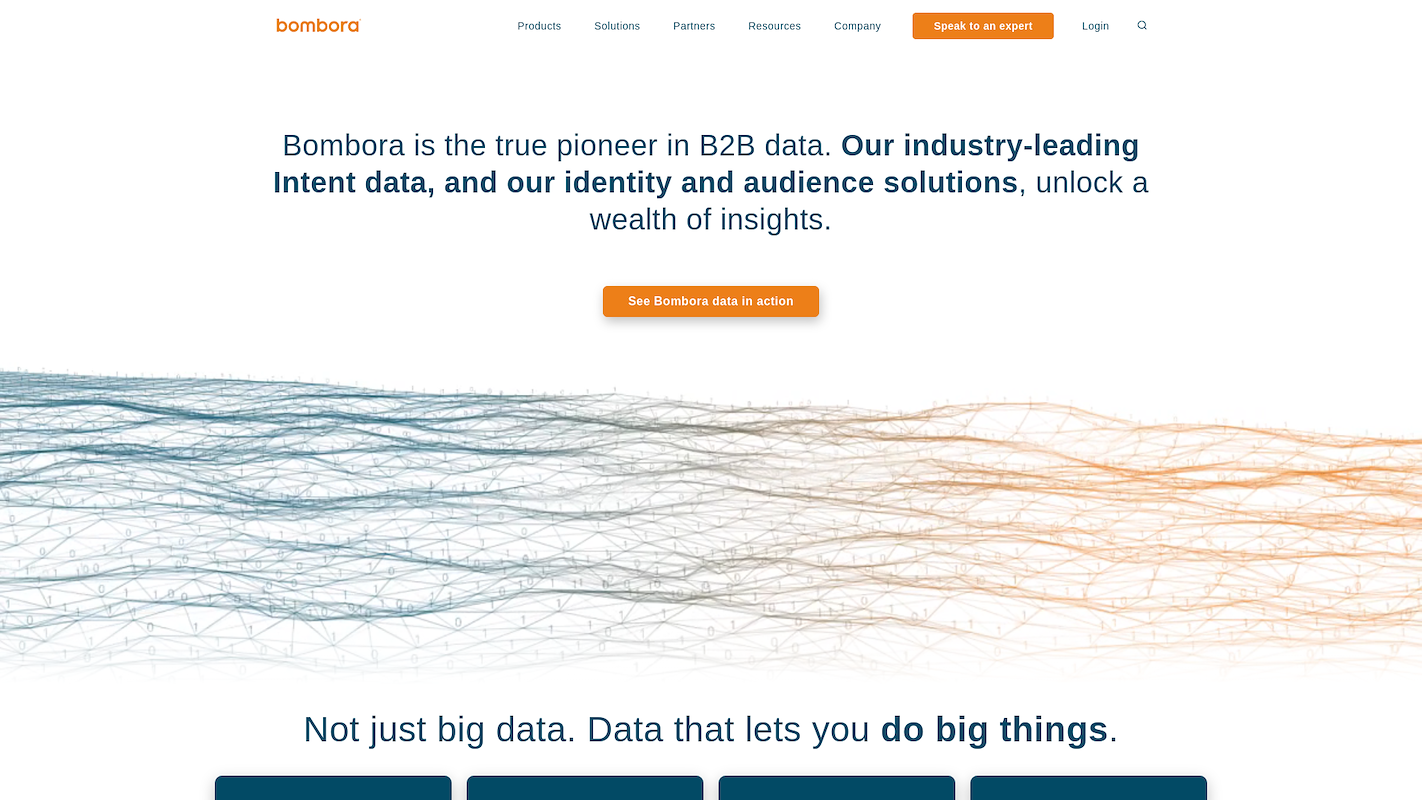
Bombora provides B2B buyer intent data. The company collects information from a cooperative of publishers, marketers, and agencies. This data shows which businesses research specific topics online. Sales and marketing teams use these signals to prioritize accounts and personalize outreach.
The information also helps inform advertising strategy. It allows teams to focus on companies that show active interest in their products or services.
Bombora's Main Features
- The platform provides company, contact, and account data, which is used to generate market and account-level insights.
- It integrates with CRM and marketing automation systems to fit into existing workflows.
- The system includes data segmentation and filtering capabilities for creating refined lead lists.
- It offers reporting and lead analysis tools to help users track performance and analyze leads.
How Bombora Compares To Slintel
Average Review score: 4.4/5 stars based on 155 G2 reviews.
- Bombora sources its intent data from a large cooperative of B2B media companies, offering a wide view of online research. Slintel, in contrast, uses its own proprietary data collection methods.
- The platform provides a Company Surge® score that measures the intensity of a company's research on specific topics. This offers a different way to prioritize accounts compared to Slintel's intent signals.
- It provides market-level insights that show content consumption trends across an entire industry. This is a broader perspective than Slintel's account-focused technographic and intent data.
- Bombora's data is a foundational source for many other sales and marketing platforms, making its signals an industry standard. Slintel's data, in comparison, is proprietary to its own tool.
Drawbacks of Bombora Compared to Slintel
- Some users find that Bombora's intent signals, sourced from a broad data co-op, can be general. In comparison, Slintel's proprietary data may offer more specific insights into a company's research on niche topics.
- Bombora's data centers on account-level intent, which sometimes means less detail on individual contacts. Slintel, in contrast, often provides specific contact information to help sales teams connect directly with decision-makers.
- Slintel specializes in detailed technographic data. Bombora, in comparison, may not offer the same depth on a company's tech stack, which can be a factor for teams that build campaigns around specific technology use.
Pricing and Cost-Effectiveness
Bombora operates on a custom pricing model and is considered a premium investment, similar to Slintel. For the most accurate pricing, we recommend visiting Bombora's official website to request a quote.
Which One Should You Go With?
The choice of a Slintel alternative depends on many variables, from budget to specific feature needs. This guide shared several options to help you make an informed decision based on your team's requirements.
If you want to automate parts of your sales process, consider 11x. Its digital workers can manage tasks like lead research and data entry, which frees up your team to sell.


